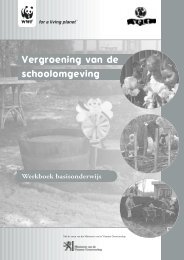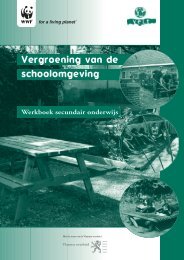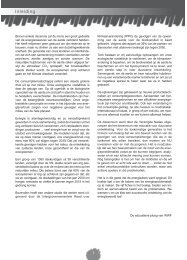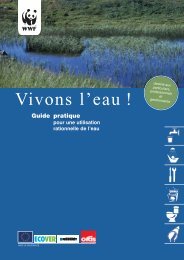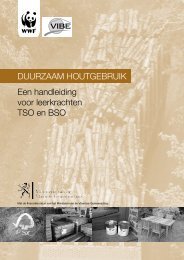Create successful ePaper yourself
Turn your PDF publications into a flip-book with our unique Google optimized e-Paper software.
Recensement des actions de stockage de l’eau en amont des bassins hydrographiques<br />
The <strong>WWF</strong> Fresh Water Unit then embarked in a water retention project called<br />
“Ardennes-Meuse”. The aim of this project is to reduce the Meuse floods downstream<br />
during strong rainfalls and to increase the water supplies during dryer periods, using<br />
ecological and sustainable solutions, by an enhancement of water retention upstream.<br />
The different aforesaid partners have identified key zones in areas that once converted<br />
and re-dynamized, will be able to act again as natural sponges thus fulfilling their role<br />
in water storage. This training course fits into this “Ardennes-Meuse” project, forming<br />
a part of a wider project, “Storage at source in Rhine and Meuse hydrographical<br />
basins”, which fits into the <strong>WWF</strong> international “One Europe More Nature” project.<br />
The latter identifies regional opportunities to show that economy and ecology can work<br />
together for an improvement of our life style, along with the protection of future<br />
generations and in keeping with nature.<br />
We distinguish two main types of approaches bound to decrease the fresh water linked<br />
issues. The first one is to act downstream from the rivers; the second one is described<br />
by the storage at source concept that aims at acting upstream from those rivers.<br />
3. Downstream sustainable solutions<br />
During this training course, many projects and experiments targeting the fitting-outs<br />
downstream from the rivers and in alluvial plains have been reviewed. Those projects<br />
that are distributed across Europe typically aim at the re-value and recovery of the<br />
original state of basins and alluvial plains. New possibilities of longer lasting water<br />
retention and floodwaters flow slowdown, by allowing more frequent inundations of<br />
these alluvial plains, are investigated by those projects.<br />
Some of them, located downstream, tend to free the rivers and streams. After fittingouts,<br />
changes of rivers directions or even sometimes without any human intervention,<br />
they evolve in a more natural morphology, similar to the one they had before. Thus,<br />
during extreme events, the entire alluvial plain is inundated and water stocked for a<br />
longer time. This kind of fitting-out is known as floodplains restoration or rivers<br />
recovery. Flood plain obstacles elimination, flood canals network lay-out, flood plain<br />
widening at a lower level, controlled inundation of particular uninhabited areas of<br />
alluvial plains, allow the water floods progression to slowdown, thus giving the water<br />
floods the time to decrease.<br />
4. Upstream sustainable solutions<br />
In the middle mountains massifs and heads of catchment areas upstream, where a lot of<br />
rivers of our countries originate, space available for water retention is not lacking.<br />
Indeed, a part of the precipitation falling over the middle mountains massifs is retained<br />
for a few days. Possibilities of water retention and storage are thus feasible there. This<br />
is the storage at source concept.<br />
In those areas close to the sources, water flow retention can be promoted by the<br />
elimination of artificial accelerated evacuation facilities (dykes, evacuation canals,<br />
river bed deepening…), humid areas and conifer forests drainage, conifer woods<br />
replacement by leafy woods, and by a part of intensive agriculture and pastures<br />
reduction.<br />
To enhance the soil adsorption capacity, there is thus often a need to modify the soil<br />
usage itself. Indeed, vegetation laying in the middle mountain massifs has almost<br />
disappeared and is replaced by fields and pastures. High peat bogs that covered about<br />
10% of those massifs surface have been subjected to the same destiny. They have been<br />
2




